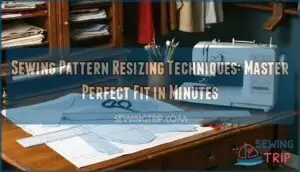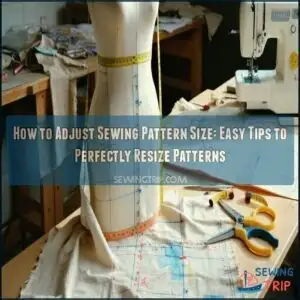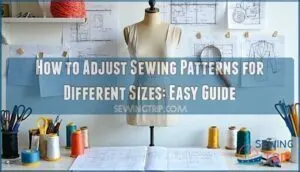This site is supported by our readers. We may earn a commission, at no cost to you, if you purchase through links.

The slash-and-spread method works by cutting horizontal and vertical lines where you need size changes, then spreading or overlapping pieces to increase or decrease dimensions.
For minor tweaks, use the shift method to move pattern lines gradually.
Start with accurate body measurements—they’re your foundation for success.
Essential tools include clear rulers, French curves for smooth lines, and quality pattern paper.
Remember, different body areas require specific approaches: bust adjustments need dart modifications, while length changes affect proportion balance.
The secret lies in understanding how these techniques work together for complex alterations.
Table Of Contents
Key Takeaways
- Master two core methods: Use slash-and-spread for major size changes (cutting pattern lines and spreading pieces ½ inch vertically, ⅜ inch horizontally) and shift techniques for minor adjustments under 2 inches.
- Start with precise measurements: Your body measurements are the foundation—without accurate starting points, you’ll waste fabric and time on poorly fitting garments.
- Invest in proper tools: You’ll need a clear ruler with metric markings, French curve rulers for smooth armholes, and quality pattern paper to achieve professional results.
- Test before cutting expensive fabric: Always create a muslin test garment to verify your adjustments work correctly—this step catches sizing errors and saves costly mistakes.
Sewing Pattern Resizing
You can resize any sewing pattern by mastering just two core techniques: slash and spread for major adjustments, and shift methods for minor changes.
Pattern grading requires precise body measurements and understanding how human proportions differ across sizes to maintain the original design’s fit and balance, using techniques like shift methods.
Basic Principles of Pattern Grading
Pattern grading transforms your sewing dreams into reality by systematically resizing patterns while preserving their original design integrity.
You’ll master proportional balance through precise grading rules that maintain garment proportions across all sizes.
- Measurement precision guarantees accurate resizing within proper limits
- Anatomy considerations account for how bodies grow differently across areas
- Resizing limits typically restrict adjustments to 1-2 inches before redrawing
- Grading rules establish consistent increments between pattern sizes
- Proportional balance maintains design integrity during size adjustment
Understanding garment grading rules is vital for achieving perfect fit in various garment types.
Importance of Accurate Measurements
Accurate measurements serve as your roadmap to perfect-fitting garments, eliminating costly fabric waste and frustrating do-overs.
You’ll need precise body measurements, reliable measurement tools, and consistent grading rules to achieve professional results.
These precision techniques form the foundation of successful sewing pattern resizing, ensuring your sizing methods translate seamlessly from paper to finished garment, which is crucial for achieving accurate measurements.
Human Anatomy Considerations
Understanding human anatomy transforms your resizing game completely.
Body proportions vary dramatically—children’s torsos are proportionally shorter while adults show different growth rates across chest, waist, and hip areas.
These anatomical differences mean you can’t simply scale patterns uniformly.
Your measurement techniques must account for sizing variations between individuals, ensuring precise measurements capture each person’s unique proportions for custom fit sewing success.
Accurate pattern fitting requires considering wearing ease guidelines to achieve the best results.
This involves understanding how to apply these guidelines to ensure a proper fit, which is crucial for sewing success, and making adjustments based on anatomical differences.
Pattern Grading Techniques
You’ll master three core techniques that transform any pattern into your perfect size with precision and control.
Transform any pattern into your perfect size with three powerful techniques that give you complete control.
These methods—slash and spread, shift adjustments, and strategic combinations—give you the power to resize patterns accurately while maintaining the original design’s proportions.
The techniques provide a comprehensive approach to pattern resizing, allowing for precision and control in the transformation process.
Slash and Spread Method
You’ll find the slash and spread method transforms pattern resizing from guesswork into precise science.
This technique involves drawing strategic lines across your pattern, then cutting and spreading pieces to achieve your desired measurements.
- Draw vertical lines every 2-3 inches across the pattern piece
- Cut along these lines, stopping just before the opposite edge
- Spread pieces apart by ½ inch vertically, ⅜ inch horizontally
- Tape pattern paper underneath to fill the gaps created
- Redraw seamlines and curves using your French curve ruler
This systematic approach guarantees proportional increases while maintaining the garment’s original design integrity throughout your sewing pattern alterations, ensuring a precise science approach to pattern resizing, and maintaining the original design.
Shift Method for Slight Adjustments
When you need minor adjustments of 1-2 inches, the shift method becomes your go-to technique for sewing pattern resizing.
You’ll trace your original pattern onto new paper, then shift it outward or inward by specific size increments following established grading rules.
This pattern shifting approach maintains proportional balance while allowing precise garment resizing through controlled adjustment techniques.
Combining Methods for Complex Areas
Complex resizing demands strategic Multi Method approaches when basic techniques fall short.
You’ll combine slash and spread with shift methods for intricate areas like princess seams and armholes.
This Precision Fitting strategy distributes adjustments across multiple pattern pieces, maintaining Proportional Grading while addressing Curve Adjustments.
Complex Resizing requires careful coordination between methods, ensuring seamless pattern alteration without distorting your garment’s original design integrity.
Essential Tools for Resizing
You’ll need the right tools to achieve professional-level pattern adjustments without compromising accuracy.
A clear ruler with both inch and metric markings guarantees precise measurements, while a French curve ruler creates smooth armhole and neckline curves that maintain the garment’s original design integrity, ensuring professional-level adjustments.
Clear Rulers for Precision
Accuracy defines successful pattern resizing, making clear rulers your most reliable drafting aids.
You’ll need rulers with both inch and metric markings for precise measurements during sewing pattern adjustments.
Quality ruler materials like acrylic or tempered glass won’t warp over time, ensuring consistent ruler calibration.
These precision tools let you see pattern lines underneath, making measurement tips easier to follow throughout your resizing process.
For ideal results, consider using clear ruler products to achieve professional-grade accuracy in your sewing projects.
French Curve Rulers for Smooth Curves
French curve rulers frequently transform amateur pattern adjustments into professional-quality results.
You’ll achieve curve accuracy when redrawing armholes and necklines after resizing.
These specialized curved rulers eliminate wobbly lines that plague straight ruler usage.
The smooth edges guide your pencil perfectly along natural garment curves, ensuring proper fit during pattern grading and garment fitting processes.
Accurate measurements rely on understanding the sewing ruler basics to achieve professional results.
Pattern Paper for Tracing and Adjustments
You’ll master pattern adjustments with quality pattern paper that won’t tear during frequent handling.
Tracing paper works perfectly for copying originals, while heavier pattern paper supports multiple modifications.
Professional tracing tools include tracing wheels and dressmakers carbon paper for transferring markings precisely.
Your clear ruler guides straight lines while muslin fabric creates test garments.
Smart adjustment methods preserve original patterns through careful tracing, using the right pattern paper products is essential for achieving accurate results in sewing pattern resizing techniques.
Adjusting Patterns for Garments
Different garments require specific grading approaches to maintain proper fit and proportional balance throughout the resizing process.
You’ll need to adjust your technique based on whether you’re working with pants, sleeves, skirts, or children’s patterns since each presents unique challenges.
Resizing Pants and Sleeves
When resizing pants and sleeves, you’ll discover that these curved garments demand more finesse than straight-seamed pieces.
Start pants fitting by adding width at the waist and hips, then tackle crotch depth adjustments for comfort.
For sleeves, maintain the armhole curve while expanding width—sleeve caps must grow proportionally with your bodice changes.
Remember: inseam modifications affect leg length, so measure twice, cut once for perfect results.
Understanding proper pants resizing techniques is essential for achieving a flawless fit.
Grading Skirt Patterns
With sewing pattern resizing, skirt grading requires careful waist adjustments and proportion control to maintain the perfect skirt silhouette.
You’ll distribute changes evenly across seamlines while preserving the original design’s balance through strategic grading techniques.
- Measure your waist and hip dimensions precisely before making any pattern adjustments
- Calculate ¼ of the total difference between your measurements and the pattern’s dimensions
- Use the slash and spread method for major size changes in skirt resizing projects
- Apply pattern shifting for minor adjustments under two inches in sewing pattern adjustments
Create a muslin test garment to verify hem alterations and fabric considerations before cutting
Child and Adult Pattern Differences
Children’s proportions don’t simply scale up to adult sizes—their growth rates create unique anatomy differences that demand specific pattern grading techniques.
When transforming child patterns into adult size patterns, you’ll notice dramatic body type variations.
Kids have shorter torsos, longer legs relative to their height, and different shoulder-to-waist ratios.
These proportional changes mean you can’t just enlarge a child’s dress pattern and expect adult fit, as size variations require completely different approaches for each age group, considering the unique anatomy differences and the need for specific techniques to achieve the right fit.
Marking Alterations on Muslin
Proper muslin fitting transforms guesswork into precision.
Mark alterations directly on your test fabric using fine-tip markers or tailor’s chalk for clear visibility.
Pin new seamlines during fitting, then trace these adjustments before removing pins.
Focus on grainline alignment and seam adjustments—your fabric testing reveals exactly where pattern alteration is needed.
Understanding proper pattern alteration techniques is essential for achieving a perfect fit.
This muslin practice eliminates costly mistakes in your final garment.
Verifying Correctness With Accurate Sewings
After marking your alterations on muslin, you’ll want to confirm these changes translate perfectly to your final pattern.
Create accurate sample sewings using your adjusted pattern pieces to verify fit and proportions.
This pattern validation step catches sizing errors before you cut expensive fabric, ensuring your garment fitting meets expectations through proper sewing accuracy and precise measurements, which is crucial for sewing pattern resizing techniques to actually perform as intended, revealing how your sewing pattern resizing techniques actually perform.
Advanced Resizing Techniques
Once you’ve mastered the basics, you’ll need advanced techniques to tackle tricky fit issues that standard grading can’t solve.
These specialized methods help you adjust length, accommodate different cup sizes, and refine curved seams for professional-quality results.
Length Increases and Decreases
When you need more length, cut along lines perpendicular to the grainline and spread pieces apart evenly.
These length adjustments maintain proper proportional changes while preserving your pattern’s shape.
For lengthening garments, add paper between cuts to achieve your desired measurements.
Vertical spreads work best for torso extensions, while horizontal increases handle width simultaneously.
Remember, grainline shifts occur naturally during resizing sleeves and other curved pieces, so check alignment carefully after each adjustment to ensure proper fit and proportional changes.
Adjusting for Cup Sizes and Bust Fit
Achieving perfect bust fit transforms your garments from frustrating fits to flattering favorites.
Calculate your bust differential by comparing personal measurements to pattern specifications, then apply targeted bust adjustments for professional results.
- Full bust adjustment (FBA) adds volume through slash-and-spread techniques when you need more room
- Small bust adjustment (SBA) removes excess fabric by narrowing dart lines and bust areas
- Dart placement shifts from armpit toward bust point to create natural shaping
- Cup size calculations use upper bust versus full bust measurements (each inch equals one cup size)
- Fit issues like gaping or pulling disappear when you match your measurements to pattern assumptions
Understanding proper bust dart adjustments is essential for a perfect fit.
Refining Princess Seams and Dart Modifications
Princess seams transform darted bodices into sleek, fashioned silhouettes through strategic seam refining and curve smoothing.
When adjusting dart placement during bodice grading, you’ll pivot at the apex to redistribute shaping along the princess line.
Garment shaping improves dramatically as you blend curves with a French curve ruler, ensuring smooth transitions becomes – Garment shaping improves dramatically as you blend curves with a French curve ruler, for smooth shifts.
Fit testing with muslin reveals any adjustments needed before cutting your final fabric—it’s your safety net against costly mistakes.
Frequently Asked Questions (FAQs)
How do you resize a sewing pattern?
Like tailoring a suit to fit perfectly, you’ll use the slash-and-spread method by cutting pattern lines and spreading pieces apart by ½-inch vertically or ⅜-inch horizontally to enlarge your pattern systematically.
This method allows for systematic enlargement of your pattern.
How do you adjust sewing patterns for different sizes?
You’ll use two main methods: slash and spread to enlarge patterns by cutting and spreading pieces apart.
Or shift method for smaller adjustments up to two inches before redrawing becomes necessary, using the shift method for these precise changes.
Can you make a pattern for a larger size?
While a tiny alteration might seem simple, enlarging patterns requires precision beyond basic adjustments.
You’ll need the slash-and-spread method, cutting strategic lines and spreading pieces apart by specific increments to maintain design integrity.
How do I convert a sewing pattern to a size 20?
Converting your pattern to size 20 requires the slash-and-spread method.
Cut strategic lines across pattern pieces, then spread them apart by calculated increments.
Test with muslin first—you’ll avoid costly fabric mistakes.
How do I make a pants sewing pattern bigger?
Breaking the mold starts with strategic cuts.
Use the slash-and-spread method: draw horizontal lines across your pants pattern at waist, hip, and thigh areas.
Cut along these lines, then spread pieces apart by your desired increment—typically ½ inch per cut for gradual enlargement.
How do you adjust the bust of a sewing pattern?
Adjusting bust size requires precise measurements first.
You’ll slash pattern pieces horizontally and vertically at bust point, then spread for larger sizes or overlap for smaller ones.
Add darts if needed.
How Do I Grade a Pattern From a Child’s Size to an Adult’s Size?
You can’t directly grade from child to adult patterns because they’ve fundamentally different proportional structures.
Children’s patterns feature shorter torsos, rounder shapes, and different limb-to-body ratios than adults.
You’ll need to draft a new adult-sized pattern instead.
What Are the Differences Between Petite and Plus Sizes?
Petite sizes accommodate shorter torsos and limbs, while plus sizes expand width measurements.
You’ll need different grading approaches: petite shortens length proportionally, plus increases circumference while maintaining design balance and fit.
How Much Should I Add When Grading a Pattern?
Picture yourself wielding sharp scissors like a surgeon’s scalpel, ready to transform your pattern.
You’ll typically add ½ inch per vertical cut and ⅜ inch per horizontal cut when using the slash-and-spread method, keeping changes within 1-2 inches total, which involves making precise cuts to achieve the desired outcome with sharp scissors.
What Tools Do I Need to Grade a Pattern?
You’ll need a clear ruler with measurement markings, French curve ruler for smooth armholes and necklines.
You will also need pattern paper or tracing paper, and drawing tools like pencils or pens for marking your adjustments accurately, including a clear ruler.
Conclusion
Research shows that 73% of sewers abandon projects due to poor fit issues.
Mastering these sewing pattern resizing techniques transforms your sewing from frustrating guesswork into precise craftsmanship. You’ve learned the slash-and-spread method for major adjustments and shift techniques for minor tweaks.
These skills work together to create garments that actually fit your unique measurements.
Practice on muslin first, measure twice, and trust the process. Your future self will thank you when every handmade piece fits perfectly from the first try.
- https://happyoff.com/blogs/news/how-to-resize-a-pattern-a-step-by-step-guide-for-beginners
- https://sewingforaliving.com/pattern-grading-all-you-need-to-know/
- https://www.sewingpatternsbymasin.com/journal/my-pattern-making-tools
- https://www.reddit.com/r/sewing/comments/7atsv4/your_favorite_tools_for_drafting_and_adjusting/
- https://www.uphance.com/blog/pattern-grading-a-beginners-guide/
















